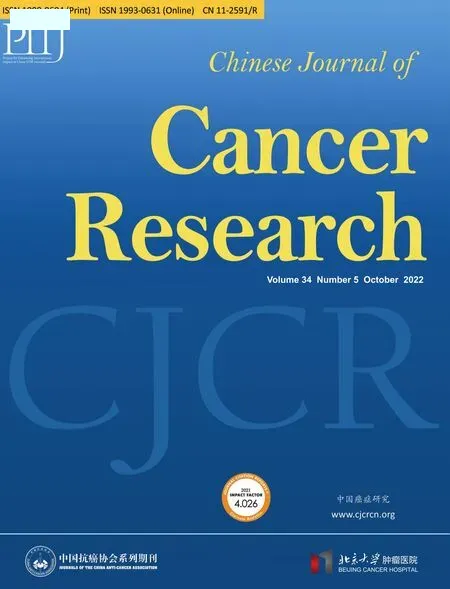Comments on National guidelines for diagnosis and treatment of prostate cancer 2022 in China (English version)
Yong Yang
Key Laboratory of Carcinogenesis and Translational Research (Ministry of Education/Beijing),Department of Urology,Peking University Cancer Hospital&Institute,Beijing 100142,China
National guidelines for diagnosis and treatment of prostate cancer 2022 in China (English version)(1) was organized by the National Health Commission of the People’s Republic of China,led by the Cancer Hospital of the Chinese Academy of Medical Sciences,and jointly compiled by well-known experts across China.On the basis of the 2018 version,the 2022 version of the guideline not only absorbs the updated content of the latest international guidelines,but also focuses on collecting some domestic evidence with a good level of evidence,and revises the relevant diagnosis and treatment recommendations to better adapt to domestic clinicians with different medical environment and resources.
From epidemiological analysis,the incidence of prostate cancer in China has increased rapidly in recent decades.As in January 2019,the National Cancer Center announced the latest incidence and mortality of malignant tumors in China in 2015.Among it,there were 72,000 new cases of prostate cancer,the incidence rate was 10.23/100,000,ranking sixth among male malignant tumors;the new death cases were about 31,000,and the mortality rate was 4.36/100,000,ranking 10th among male malignant tumors;Surgeons will face enormous challenges for the large number of prostate cancer patients.
In theNational guidelines for diagnosis and treatment of prostate cancer 2022 in China (English version),the clinical diagnosis,pathological evaluation criteria and clinical staging of prostate cancer follow the latest international guidelines.However,at present,about 30%-40% of prostate cancers in China are metastatic prostate cancer at the initial diagnosis,and regardless of the clinical stage at the initial diagnosis,the proportion of patients with highgrade prostate cancer (≥8 points) is as high as 40%.These data suggest that the importance of screening for prostate cancer in China is obviously greater than that in the United States or European countries.Due to the high degree of malignancy and late diagnosis of prostate cancer patients in China,it may also be the reason why the 5-year survival rate of prostate cancer patients in China is significantly lower than that in Europe and North America (2,3).Therefore,this guideline proposes the necessity of prostate cancer screening for the population in China.
The diagnosis and treatment of prostate cancer basically follow the international mainstream guidelines of oncourology,which also reflects that China has basically possessed the same diagnostic technology,surgical equipment,surgical technology and anti-cancer drug resources as the international ones in related fields.In view of China’s vast geography and different medical resources in different regions,for many more advanced diagnosis and treatment,the guideline gives only optional recommendations,which not only reflects the level of diagnosis and treatment in China,but also takes into account differences between provinces and cities of China.For example,radical prostatectomy,not only minimally invasive surgery (laparoscopic and robotic),but also open surgery is recommended for low-risk prostate cancer,due to cultural differences in China since patients and their families usually have serious concerns about active surveillance.For high-risk prostate cancer,the guideline more recommends radical prostatectomy,fully considering that the radiotherapy equipment is expensive and has not been widely popularized in China;while radical prostatectomy has been widespread with decades of efforts by high-level doctors in China.However,recommendations for preoperative neoadjuvant therapy and postoperative adjuvant therapy for high-risk prostate cancer are also proposed in line with international research results.
Radiotherapy techniques including conformal radiotherapy (CRT),intensity-modulated radiotherapy(IMRT),proton radiotherapy,brachytherapy,cryoablation,high-intensity focused ultrasound (HIFU),and other local treatments for prostate cancer have been carried out in China,and corresponding indications have also been recommended in this guideline.
Recommendations for the diagnosis and treatment of metastatic prostate cancer not only reflect many available drug options in China,but also incorporate international research progress in recent years,which including androgen deprivation therapy (ADT) combined with NHT,ADT combined with docetaxel chemotherapy in the metastatic hormone-sensitive prostate cancer (mHSPC)stage.Considering the availability of drugs in different regions of China,the treatment plan of ADT combined with a first-generation anti-androgen drug was retained and the corresponding indications were recommended for selected elderly.
For castration-resistant prostate cancer (CRPC) patients,the recommendations of this guideline are basically the same as those of the international guideline,reflecting that China has reached international standards in genetic testing,molecular diagnosis and molecular targeted radionuclide therapy,and showing that advanced treatment methods such as PARPi,second-generation anti-androgen,programmed death 1 and its ligand (PD-1/PD-L1)inhibitors,radium 223,and177Lu-PSMA have also been popularized and accumulated clinical experience in China.For the application of bone protection agents for bone metastases,the resources available in China are basically synchronized with those in the world,and therefore,the recommendations are basically the same as those of the international mainstream guidelines.
In general,National guidelines for diagnosis and treatment of prostate cancer 2022 in China (English version)basically reflect the current situation of prostate cancer treatment in China,and also show considerable experience and resources accumulated in the diagnosis and treatment of prostate cancer in our country.This guideline integrates the latest progress in international research on prostate cancer and the accumulated results of long-term research,and also fully considers the differences in medical resources in various provinces and cities of China.We believe that it can provide a good guarantee for standardized treatment of prostate cancer patients in China.
Acknowledgements
None.
Footnote
Conflicts of Interest: The author has no conflicts of interest to declare.
 Chinese Journal of Cancer Research2022年5期
Chinese Journal of Cancer Research2022年5期
- Chinese Journal of Cancer Research的其它文章
- Comments on National guidelines for diagnosis and treatment of thyroid cancer 2022 in China (English version)
- Comments on National guidelines for diagnosis and treatment of breast cancer 2022 in China (English version)
- Comments on National guidelines for diagnosis and treatment of gastric cancer 2022 in China (English version)
- Comments on National guidelines for diagnosis and treatment of cervical cancer 2022 in China (English version)
- Perspectives of laparoscopic surgery for gastric cancer
- Beyond images: Emerging role of Raman spectroscopy-based artificial intelligence in diagnosis of gastric neoplasia
